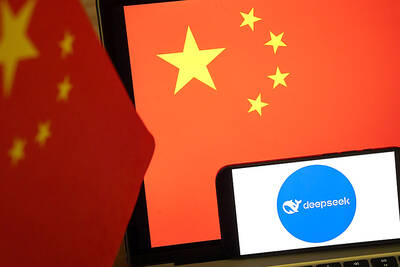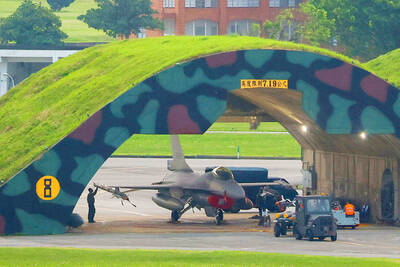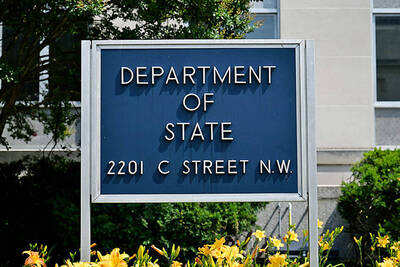A new “carrier killer” missile that has become a symbol of China’s rising military might will not force the US Navy to change the way it operates in the Pacific, a senior Navy commander said.
Defense analysts say the Dong Feng 21D missile could upend the balance of power in Asia, where US aircraft carrier battle groups have ruled the waves since the end of World War II.
However, Vice Admiral Scott van Buskirk, commander of the US 7th Fleet, said that the Navy does not see the much-feared weapon as creating any insurmountable vulnerability for the US carriers — the Navy’s crown jewels.
“It’s not the Achilles heel of our aircraft carriers or our Navy — it is one weapons system, one technology that is out there,” Van Buskirk said in an interview this week on the bridge of the USS George Washington, the only carrier that is home-based in the western Pacific.
The DF-21D is unique in that it is believed capable of hitting a powerfully defended moving target — like the USS George Washington — with pinpoint precision. That objective is so complex that the Soviets gave up on a similar project.
The missile would penetrate defenses because its speed from launch would not allow enough time for carriers or other large ships to complete countermeasures.
That could seriously weaken Washington’s ability to intervene in any potential conflict over Taiwan or North Korea, as well as deny US ships safe access to international waters near China’s long coastline.
Van Buskirk, whose fleet is responsible for most of the Pacific and Indian oceans, with 60-70 ships and 40,000 sailors and Marines under its command, said the capabilities of the Chinese missile are as yet unproven. However, he acknowledged it does raise special concerns.
“Any new capability is something that we try to monitor,” he said.
“If there wasn’t this to point to as a game changer, there would be something else,” he said. “That term has been bandied about for many things. I think it really depends on how you define the game, whether it really changes it or not. It’s a very specific scenario for a very specific capability — some things can be very impactful.”
The development of the missile comes as China is increasingly venturing further out to sea and is becoming more assertive around its coastline and in disputes over territory.
Late last year, China and Japan were locked in a heated diplomatic row over several islands both claim in the East China Sea, an area regularly patrolled by US Navy vessels. A flotilla of 10 Chinese warships, including advanced submarines and destroyers, passed through the Miyako Strait last April in the biggest transit of its kind to date.
Experts saw it as an attempt by China to test Japan and the US and demonstrate its open water capabilities.
Van Buskirk said the US Navy has no intention of altering its mission because of the new threat and will continue to operate in the seas around Japan, South Korea, the Philippines and anywhere else it deems necessary.
“We won’t change these operations because of this specific technology that might be out there, but we will carefully monitor and adapt to it,” he said.
The faster-than-expected development of the missile has set off alarm bells in Washington.
In December, Admiral Robert Willard, the head of the US Pacific Command, told Japan’s Asahi Shimbun he believed the missile program had achieved “initial operational capability,” meaning a workable design had been settled on and was being further developed.
At its most capable, the DF-21D could be launched from land with enough accuracy to penetrate the defenses of even the most advanced moving aircraft carrier at a distance of more than 1,500km.
To allay regional security fears, van Buskirk said, China needs to be more forthcoming about its intentions.

MISINFORMATION: The generated content tends to adopt China’s official stance, such as ‘Taiwan is currently governed by the Chinese central government,’ the NSB said Five China-developed artificial intelligence (AI) language models exhibit cybersecurity risks and content biases, an inspection conducted by the National Security Bureau (NSB) showed. The five AI tools are: DeepSeek, Doubao (豆包), Yiyan (文心一言), Tongyi (通義千問) and Yuanbao (騰訊元寶), the bureau said, advising people to remain vigilant to protect personal data privacy and corporate business secrets. The NSB said it, in accordance with the National Intelligence Services Act (國家情報工作法), has reviewed international cybersecurity reports and intelligence, and coordinated with the Ministry of Justice Investigation Bureau and the National Police Agency’s Criminal Investigation Bureau to conduct an inspection of China-made AI language

BOOST IN CONFIDENCE: The sale sends a clear message of support for Taiwan and dispels rumors that US President Donald Trump ‘sold out’ the nation, an expert said The US government on Thursday announced a possible sale to Taiwan of fighter jet parts, which was estimated to cost about US$330 million, in a move that an expert said “sends a clear message of support for Taiwan” amid fears that Washington might be wavering in its attitude toward Taipei. It was the first announcement of an arms sale to Taiwan since US President Donald Trump returned to the White House earlier this year. The proposed package includes non-standard components, spare and repair parts, consumables and accessories, as well repair and return support for the F-16, C-130 and Indigenous Defense Fighter aircraft,

CHECKING BOUNDARIES: China wants to disrupt solidarity among democracies and test their red lines, but it is instead pushing nations to become more united, an expert said The US Department of State on Friday expressed deep concern over a Chinese public security agency’s investigation into Legislator Puma Shen (沈伯洋) for “secession.” “China’s actions threaten free speech and erode norms that have underpinned the cross-strait ‘status quo’ for decades,” a US Department of State spokesperson said. The Chongqing Municipal Public Security Bureau late last month listed Shen as “wanted” and launched an investigation into alleged “secession-related” criminal activities, including his founding of the Kuma Academy, a civil defense organization that prepares people for an invasion by China. The spokesperson said that the US was “deeply concerned” about the bureau investigating Shen

DISPUTE: A Chinese official prompted a formal protest from Tokyo by saying that ‘the dirty head that sticks itself out must be cut off,’ after Takaichi’s Taiwan remarks Four armed China Coast Guard vessels yesterday morning sailed through disputed waters controlled by Japan, amid a diplomatic spat following Japanese Prime Minister Sanae Takaichi’s comments on Taiwan. The four ships sailed around the Senkaku Islands — known as the Diaoyutai Islands (釣魚台) to Taiwan, and which Taiwan and China also claim — on Saturday before entering Japanese waters yesterday and left, the Japan Coast Guard said. The China Coast Guard said in a statement that it carried out a “rights enforcement patrol” through the waters and that it was a lawful operation. As of the end of last month,